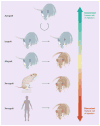Achieving stable human stem cell engraftment and survival in the CNS: is the future of regenerative medicine immunodeficient?
- PMID: 21548741
- PMCID: PMC3403688
- DOI: 10.2217/rme.11.22
Achieving stable human stem cell engraftment and survival in the CNS: is the future of regenerative medicine immunodeficient?
Abstract
There is potential for a variety of stem cell populations to mediate repair in the diseased or injured CNS; in some cases, this theoretical possibility has already transitioned to clinical safety testing. However, careful consideration of preclinical animal models is essential to provide an appropriate assessment of stem cell safety and efficacy, as well as the basic biological mechanisms of stem cell action. This article examines the lessons learned from early tissue, organ and hematopoietic grafting, the early assumptions of the stem cell and CNS fields with regard to immunoprivilege, and the history of success in stem cell transplantation into the CNS. Finally, we discuss strategies in the selection of animal models to maximize the predictive validity of preclinical safety and efficacy studies.
Figures

References
-
- Cummings BJ, Uchida N, Tamaki SJ, et al. Human neural stem cells differentiate and promote locomotor recovery in spinal cord-injured mice. Proc Natl Acad Sci USA. 2005;102(39):14069–14074. First study to use an immunodeficient mouse model for human neural stem cell transplantation into the injured CNS. - PMC - PubMed
-
- Lu B, Malcuit C, Wang S, et al. Long-term safety and function of RPE from human embryonic stem cells in preclinical models of macular degeneration. Stem Cells. 2009;27(9):2126–2135. - PubMed
-
- Thomson JA, Itskovitz-Eldor J, Shapiro SS, et al. Embryonic stem cell lines derived from human blastocysts. Science. 1998;282(5391):1145–1147. - PubMed
-
- Takahashi K, Tanabe K, Ohnuki M, et al. Induction of pluripotent stem cells from adult human fibroblasts by defined factors. Cell. 2007;131(5):861–872. - PubMed
MeSH terms
Grants and funding
LinkOut - more resources
Full Text Sources
Other Literature Sources
Medical
